Between Addiction and Immersion: A Correlational Study of Digital and Academic Behaviour Among Engineering Students
Abstract
1. Introduction
2. Problem Statement
3. Hypotheses
- H0 (Null Hypothesis): There is no statistically significant relationship between DB and AB.
- H1 (Addiction Trend Hypothesis): There is a negative and statistically significant correlation between DB and AB, suggesting a potential trend toward academically disruptive digital engagement.
- H2 (Immersion Trend Hypothesis): There is a positive and statistically significant correlation between DB and AB, suggesting a possible trend toward immersive digital engagement.
- H3 (Group Differences Hypothesis): There are statistically significant differences in DB and/or AB based on students’ academic year or gender.
4. Methodology
4.1. Research Design
4.2. Participants and Sampling
4.3. Research Instrument
- The DB section measured students’ engagement with digital technology, capturing behaviours associated with digital addiction (e.g., compulsive usage, procrastination due to online activities, digital distraction) as well as aspects of digital immersion (e.g., use of technology for academic purposes).
- The AB section assessed students’ self-reported ABs and outcomes in the context of their digital use. Items focused on study habits and perceived AB. This scale is not a direct measure of grades, but rather students’ perception of their academic efficacy and habits (which tend to correlate with academic success).
4.4. Reliability and Validity
5. Results
5.1. Digital Behaviour Among Engineering Students
- The highest-rated behaviour was related to excessive non-academic internet use. For instance, Item DB1 received the highest agreement (mean = 4.53, SD = 0.665). This suggests that a large portion of students spend a significant amount of time online unrelated to coursework, reflecting a prevalent habit of heavy daily digital consumption.
- Students demonstrated a strong recognition of potential negative associations with their digital habits. Notably, Item DB10 showed a high mean agreement score of 4.45 (SD = 0.895). While phrased using addiction terminology, this result suggests substantial student awareness of possible links between their digital behaviour and academic outcomes.
- Several items highlighted the interference of digital devices with study routines. For example, DB2 (mean = 4.37) and DB3 (mean = 4.34) were both among the top-rated behaviours. Such high means indicate that the majority of students frequently experience digital distractions during times that are meant for learning, reinforcing concerns that digital immersion can erode concentration and academic focus.
- On the lower end (though still above the neutral midpoint), DB6 had a relatively lower mean of 3.74 (SD = 0.809). This suggests that not all students struggle equally with initiating study activities in the face of digital distractions; some may have strategies to eventually get started, even if procrastination is common.
5.2. Academic Behaviour in the Context of Digital Use
- Among all academic behaviour items, AB5, related to students’ ability to manage their time, received the highest mean score of 4.13 (SD = 0.978). Many students believed they could effectively manage their time despite digital distractions, indicating a degree of confidence or perceived control over their study schedule. This is an encouraging sign, hinting that students are at least aware of the need for balance and feel capable of it, even if their digital habits are heavy.
- In a similar vein, AB9 was relatively highly endorsed (mean = 3.75). This implies that a considerable number of students attempt to harness digital tools productively for their studies, reflecting an intention to convert digital immersion into academic gain.
- Conversely, the lowest-rated AB item was AB8 with a mean of 3.11 (SD = 0.836). This was the only item that hovered around a neutral response on average. This suggests that, although students recognise the need to control digital use, many have not yet developed practical, sustained strategies. This gap between awareness and action is also evident in AB6 (mean = 3.16), where students only mildly agreed, implying they do not fully perceive the academic benefits of reducing leisure digital activities.
5.3. Investigating the Correlation Between DB and AB
5.4. Differences by Academic Year and Gender
5.4.1. Differences by Year of Study
5.4.2. Differences by Gender
6. Discussion
6.1. Digital Behaviour vs. Academic Behaviour Relationship
6.2. Academic Maturity and Digital Self-Regulation
6.3. Gender and Digital-Academic Interactions
7. Conclusions
8. Recommendations
- Universities: Universities should offer standalone workshops (or workshops as part of a module) on managing DB, particularly as part of a curriculum for first-year engineering students transitioning into new academic expectations and a new digitally mediated educational environment. These workshops need to include effective strategies immediately implementable by students, such as identifying digital distractions, time management skills, and using technology to support learning rather than derail learning. In addition to promoting effective DBs, universities could encourage the use of productivity apps and tools that can help students monitor and control their screen time, so students can, rather than only seeking to improve DBs, establish digital habits that are sustainable.
- Students: Students need to distinguish clearly between their academically based digital activities and digital leisure activities. Tactics such as creating separate user profiles or browser accounts (one for study and another for recreation) are an example of practical strategies that can create a mental “boundary” between digital study and leisure; if a mental separation is established, students will be less susceptible to distraction by digital media. Moreover, students should build habits of self-monitoring, such as keeping a digital diary, and reflecting on their DB’s contributions to study their productivity and levels of stress. This type of self-monitoring would help students become aware of their digital habits, although enhanced awareness may alter their subsequent behaviour.
- Academic support services: Universities need to diversify academic support services to include direct support for individual students via counselling activities and digital literacy coaching; effective academic support needs to “help the student identify their individual behaviours”. Universities can offer peer support groups and campaigns for digital wellness and academic success that help develop social capital that values a community/collective disposition toward mindful technology.
- Future Research: To further investigate the link between DB and AB, future studies are encouraged to correlate DB scores with objective academic indicators, such as semester GPA or final course results. This would help validate the relationship between digital engagement and academic outcomes more reliably than self-reported AB alone. It is also recommended that researchers longitudinally track digital behaviour to see how it changes over time and how those changes relate to overall academic progression. Establishing this type of causal link between digital behaviour and academic achievement would also help to identify important points in time to intervene with students.
Author Contributions
Funding
Institutional Review Board Statement
Informed Consent Statement
Data Availability Statement
Conflicts of Interest
Abbreviations
| ANOVA | Analysis of Variance |
| AB | Academic Behaviour |
| DB | Digital Behaviour |
| GPA | Grade Point Average |
| SPSS | Statistical Package for the Social Sciences |
References
- Agrawal, S., Simon, A., Bech, S., Bærentsen, K. B., & Forchammer, S. (2019). Defining immersion: Literature review and implications for research on immersive audiovisual experiences. In 147th AES convention (p. 10275). Audio Engineering Society. [Google Scholar] [CrossRef]
- Alaleeli, S., & Alnajjar, A. (2020). The Arab digital generation’s engagement with technology: The case of high school students in the UAE. Journal of Technology and Science Education, 10(1), 159–178. [Google Scholar] [CrossRef]
- Billieux, J., Schimmenti, A., Khazaal, Y., Maurage, P., & Heeren, A. (2015). Are we overpathologizing everyday life? A tenable blueprint for behavioral addiction research. Journal of Behavioral Addictions, 4(3), 119–123. [Google Scholar] [CrossRef]
- Boumosleh, J., & Jaalouk, D. (2018). Smartphone addiction among university students and its relationship with academic performance. Global Journal of Health Science, 10(1), 48–59. [Google Scholar] [CrossRef]
- Chiu, S.-I. (2014). The relationship between life stress and smartphone addiction on Taiwanese university students: A mediation model of learning self-efficacy and social self-efficacy. Computers in Human Behavior, 34, 49–57. [Google Scholar] [CrossRef]
- Cohen, J. (1988). Statistical power analysis for the behavioral sciences (2nd ed.). Lawrence Erlbaum Associates. [Google Scholar] [CrossRef]
- Dahl, D., & Bergmark, K. H. (2020). Persistence in problematic internet use—A systematic review and meta-analysis. Frontiers in Sociology, 5, 30. [Google Scholar] [CrossRef]
- Endomba, F. T., Moukouri, D. P., Maloum, E. I., & Foute, C. H. N. (2022). Prevalence of internet addiction in Africa: A systematic review and meta-analysis. Journal of Behavioral Addictions, 11(3), 739–753. [Google Scholar] [CrossRef]
- Etchells, P. (2024). Unlocked: The real science of screen time (and how to spend it better). HarperCollins. [Google Scholar]
- Grewe, M., & Gie, L. (2023). Can virtual reality have a positive influence on student engagement? South African Journal of Higher Education, 37(5), 124–141. [Google Scholar] [CrossRef]
- Grifa, D. (2023). Prevalence of internet addiction among a sample of Tripoli university students. International Journal of Humanities and Educational Research, 5(2), 14–26. [Google Scholar] [CrossRef]
- Gu, J., Wu, P., Luo, Y., He, X., Fu, L., Liu, H., Lin, F., Xu, Q., & Wu, X. (2023). Internet addiction, loneliness, and academic burnout among Chinese college students: A mediation model. Frontiers in Psychiatry, 14, 1176596. [Google Scholar] [CrossRef]
- Janssen, D., Tummel, C., Richert, A., & Isenhardt, I. (2016). Virtual environments in higher education—Immersion as a key construct for learning 4.0. International Journal of Advanced Corporate Learning (iJAC), 9(2), 20–26. [Google Scholar] [CrossRef]
- Khan, Y. M., Shah, M. H., & Sahibzada, H. E. (2020). Impact of self-regulated learning behavior on the academic achievement of university students. FWU Journal of Social Sciences, 14(2), 117–130. [Google Scholar] [CrossRef]
- Li, F., Cheng, L., Wang, X., Shen, L., Ma, Y., & Islam, A. Y. M. A. (2025). The causal relationship between digital literacy and students’ academic achievement: A meta-analysis. Humanities and Social Sciences Communications, 12, 108. [Google Scholar] [CrossRef]
- Liu, T., Cheng, Y., Luo, Y., Wang, Z., Pang, P. C., Xia, Y., & Lau, Y. (2024). The impact of social media on children’s mental health: A systematic scoping review. Healthcare, 12(23), 2391. [Google Scholar] [CrossRef]
- Moses, S. (2023). Impact of digital literacy skills on students’ engagement and academic performance in senior secondary schools in chikun local government, Kaduna State, Nigeria. Zaria Journal of Educational Studies, 24(1), 76–82. [Google Scholar]
- Nkomo, L. M., Daniel, B. K., & Butson, R. J. (2021). Synthesis of student engagement with digital technologies: A systematic review of the literature. International Journal of Educational Technology in Higher Education, 18, 34. [Google Scholar]
- Nunnally, J. C., & Bernstein, I. H. (1994). Psychometric theory (3rd ed.). McGraw-Hill. [Google Scholar]
- Radtke, T., Apel, T., Schenkel, K., Keller, J., & von Lindern, E. (2022). Digital detox: An effective solution in the smartphone era? A systematic literature review. Mobile Media & Communication, 10(3), 286–305. [Google Scholar] [CrossRef]
- Renjith, R., & Arundev, P. R. (2024). Exploring the interplay of digital addiction and academic performance: A regression analysis approach. Educational Administration: Theory and Practice, 30(5), 765–775. [Google Scholar] [CrossRef]
- Samaha, M., & Hawi, N. S. (2016). Relationships among smartphone addiction, stress, academic performance, and satisfaction with life. Computers in Human Behavior, 57, 321–325. [Google Scholar] [CrossRef]
- Sha, P., Sariyska, R., Riedl, R., Lachmann, B., & Montag, C. (2019). Linking internet communication and smartphone use disorder: A closer look at Facebook and WhatsApp. Addictive Behaviors Reports, 9, 100148. [Google Scholar] [CrossRef]
- Small, G. W., Lee, J., Kaufman, A., Jalil, J., Siddarth, P., Gaddipati, H., Moody, T. D., & Bookheimer, S. Y. (2020). Brain health consequences of digital technology use. Dialogues in Clinical Neuroscience, 22(2), 179–187. [Google Scholar] [CrossRef]
- Sunday, O. J., Adesope, O. O., & Maarhuis, P. L. (2021). The effects of smartphone addiction on learning: A meta-analysis. Computers in Human Behavior Reports, 4, 100114. [Google Scholar] [CrossRef]
- Wu, W., & Yuan, L. (2023). The relationship between digital literacy and academic performance of college students in blended learning: The mediating effect of learning adaptability. Advances in Educational Technology and Psychology, 7(8), 77–87. [Google Scholar] [CrossRef]
- Yuan, X., Rehman, S., Altalbe, A., Sabah, S., & Altamimi, A. (2024). Digital literacy as a catalyst for academic confidence: Exploring the interplay between academic self-efficacy and academic procrastination among medical students. BMC Medical Education, 24, 1317. [Google Scholar] [CrossRef]
- Yuan, Y., He, X., He, Q., Jia, Y., Xu, Z., & Li, M. (2023). Problematic mobile phone use and time management disposition in Chinese college students: The chain mediating role of sleep quality and cognitive flexibility. BMC Psychology, 11, 440. [Google Scholar] [CrossRef]
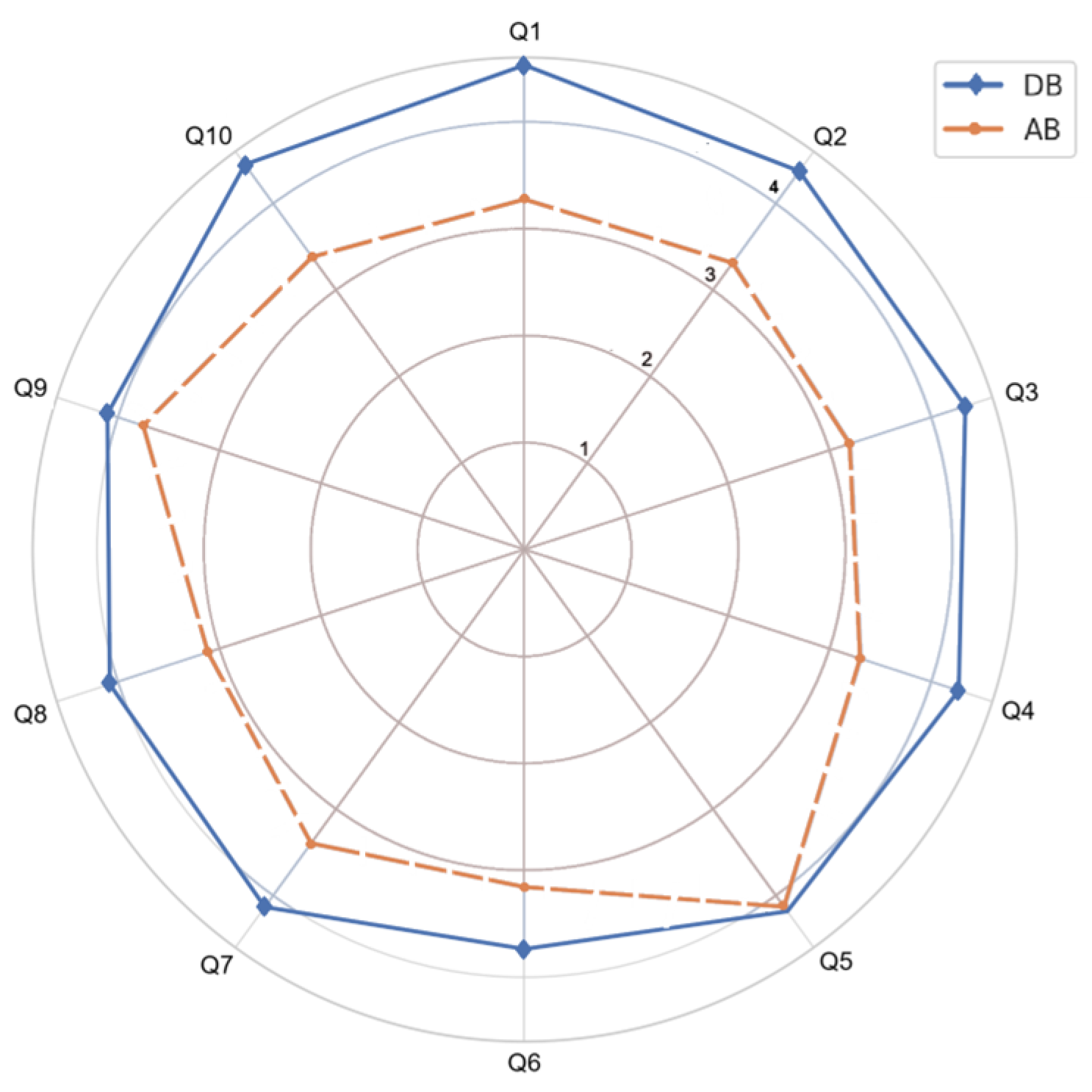
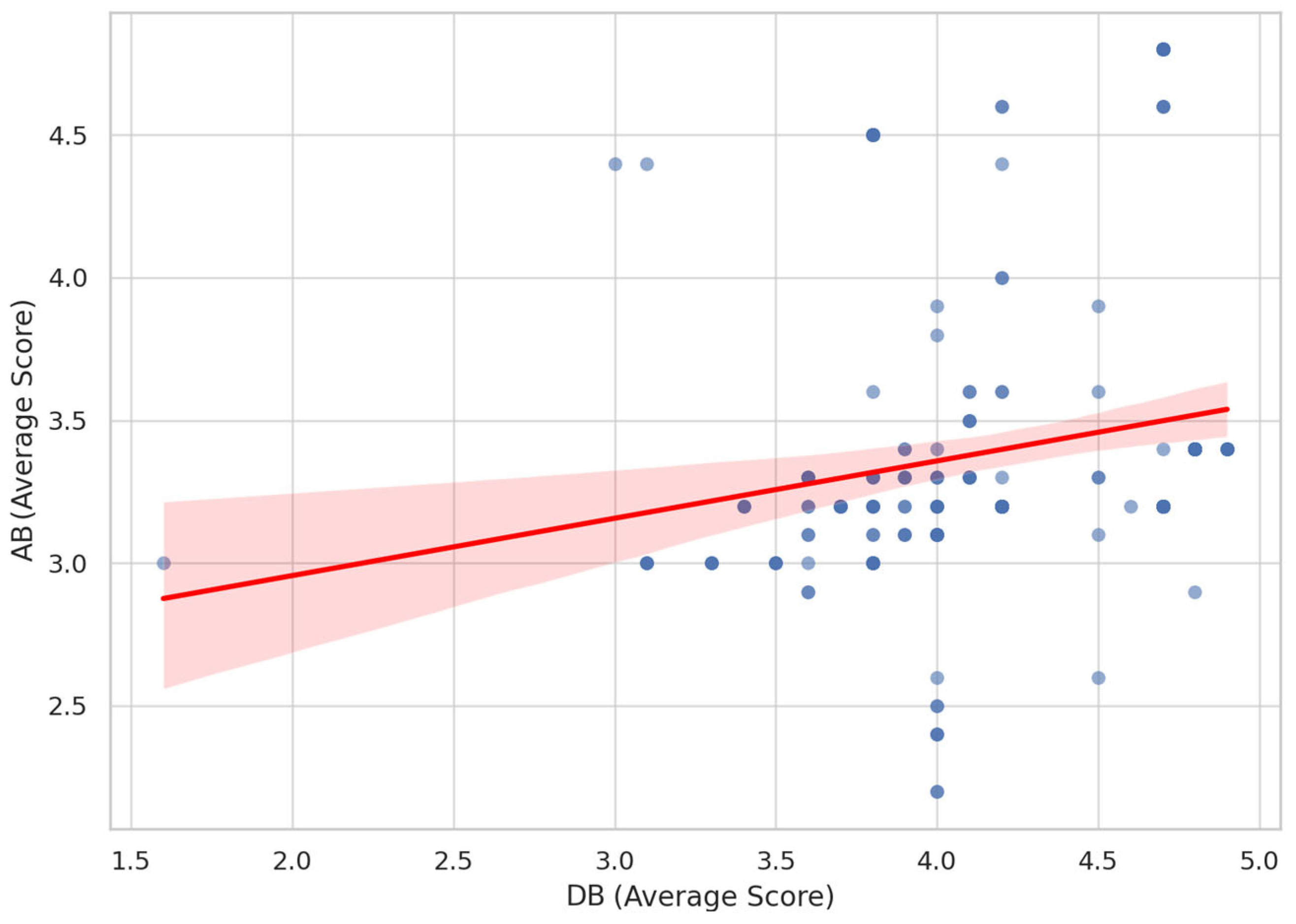
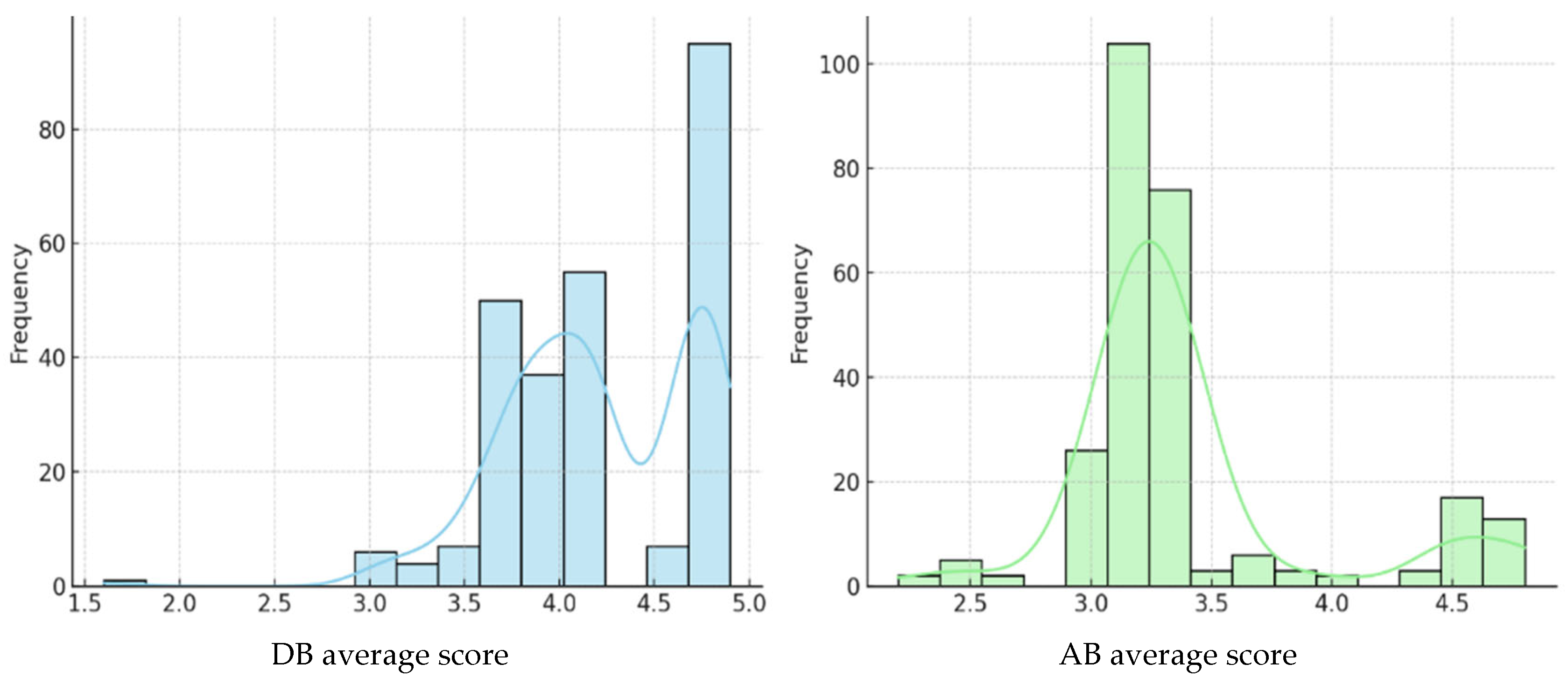

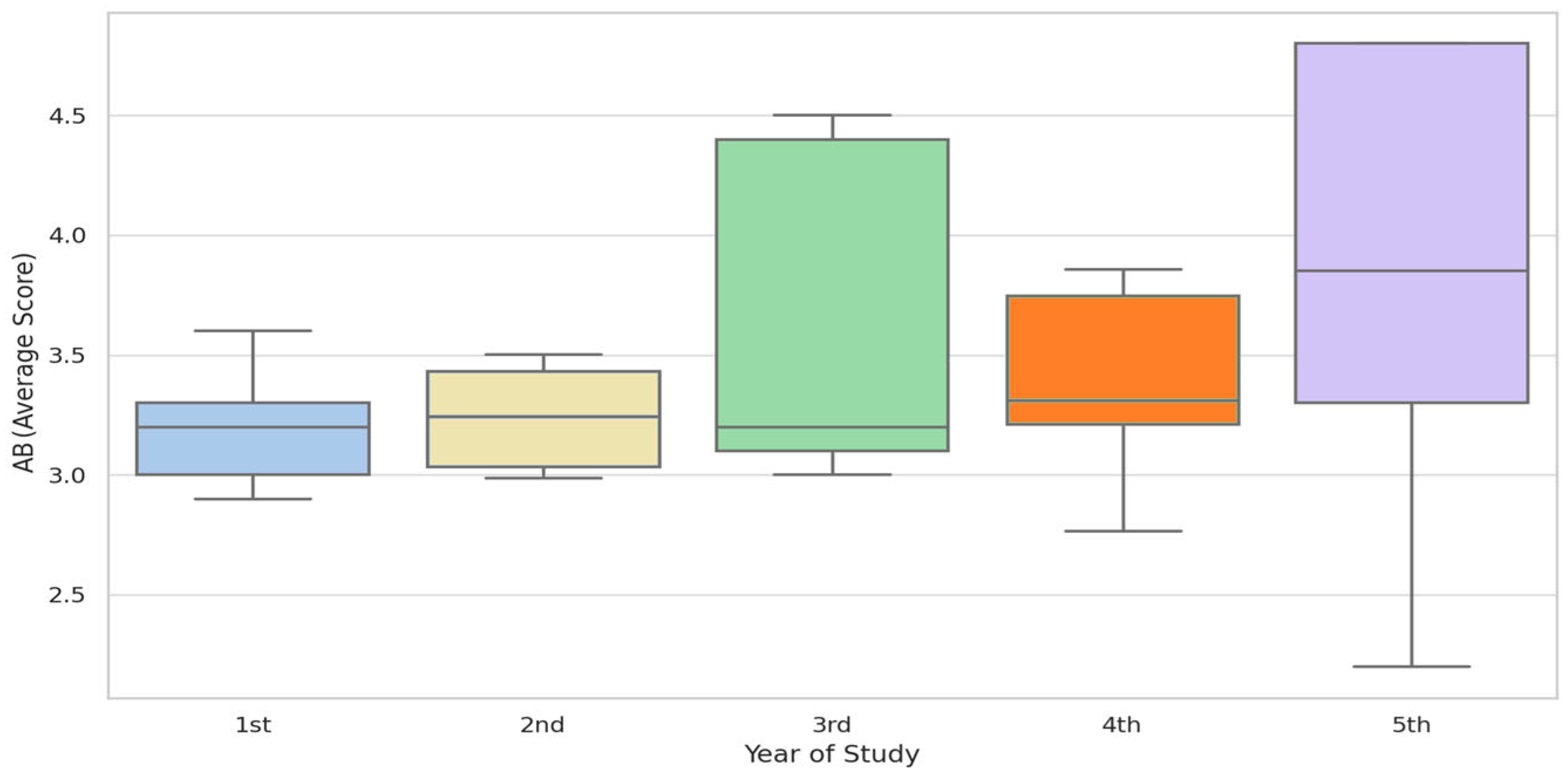
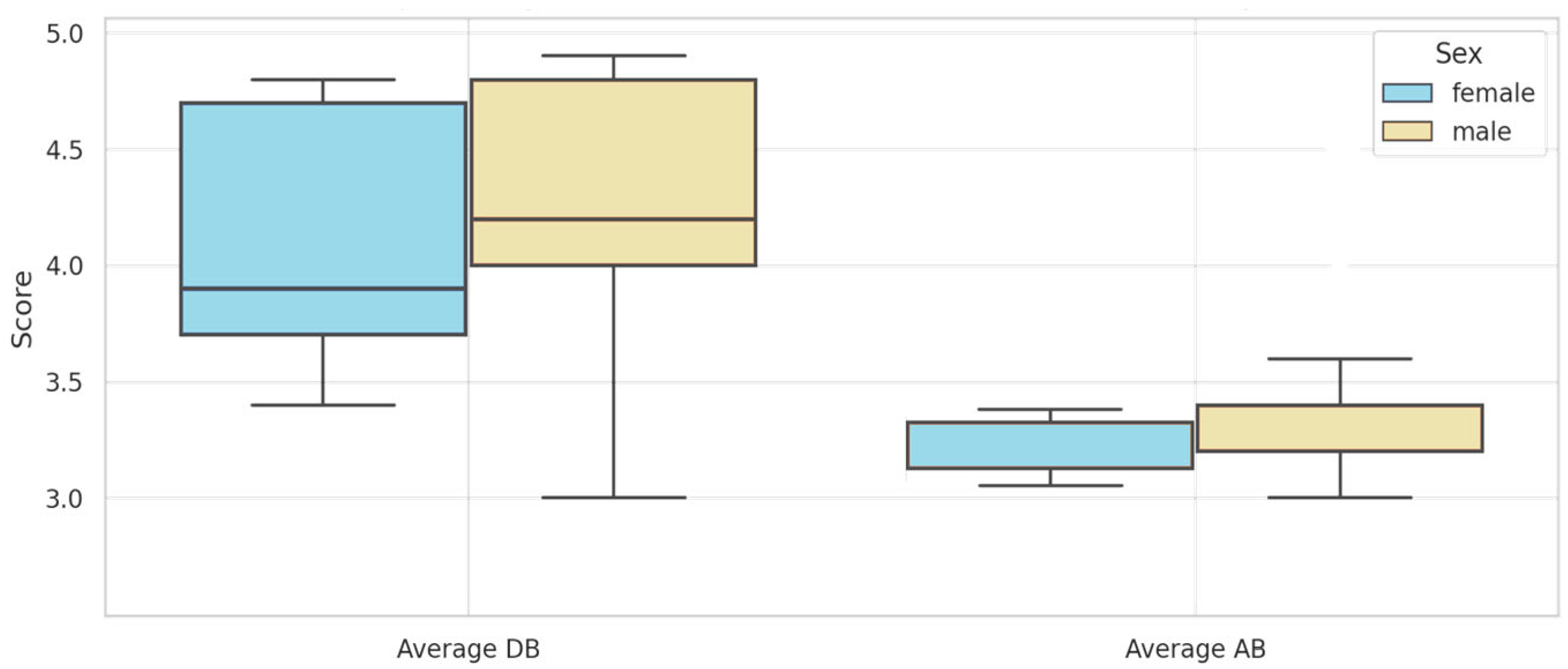
| Independent Variable (DB) Items | |
| DB1 | I spend more than 5 h daily online outside of study-related activities. |
| DB2 | I use my smartphone during lectures or study time. |
| DB3 | I find it difficult to stay away from social media while studying. |
| DB4 | I feel an urgent desire to check notifications even during study time. |
| DB5 | Using the internet affects the organisation of my study time. |
| DB6 | I face difficulty in starting my studies due to being distracted by digital content. |
| DB7 | I postpone my academic tasks due to browsing the internet or watching videos. |
| DB8 | I use the internet or electronic games as a way to escape from academic stress. |
| DB9 | I feel exhausted or tired due to prolonged nights spent on the internet. |
| DB10 | I believe that my addiction to technology negatively impacts my academic and social life. |
| Dependent Variable (AB) Items | |
| AB1 | I make sure to reduce the use of digital devices during study periods. |
| AB2 | I am able to focus during study sessions without being distracted by digital content. |
| AB3 | I complete my academic tasks on time without delay due to digital usage. |
| AB4 | I am able to prepare for lectures and exams without digital addiction affecting my academic behaviour. |
| AB5 | I am able to organise my time between studying and digital use in a balanced way. |
| AB6 | I notice an improvement in my academic results when I reduce my use of non-educational digital content. |
| AB7 | I am able to interact effectively with my peers and professors in an academic environment without the negative impact of digital addiction. |
| AB8 | I have strategies to control my digital usage, which helps enhance my academic behaviour. |
| AB9 | I make sure to use technology in a way that contributes to improving my academic level rather than hindering it. |
| AB10 | I am able to complete academic research and projects without digital usage affecting the quality of the work |
| DB Item | DB1 | DB2 | DB3 | DB4 | DB5 | DB6 | DB7 | DB8 | DB9 | DB10 | Average |
|---|---|---|---|---|---|---|---|---|---|---|---|
| Average | 4.53 | 4.37 | 4.34 | 4.27 | 4.18 | 3.74 | 4.13 | 4.08 | 4.1 | 4.45 | 4.22 |
| SD | 0.665 | 0.653 | 0.645 | 0.677 | 0.766 | 0.809 | 0.644 | 0.67 | 0.947 | 0.895 | 0.548 |
| Rank | 1 | 3 | 4 | 5 | 6 | 10 | 7 | 9 | 8 | 2 |
| Statement | AB1 | AB2 | AB3 | AB4 | AB5 | AB6 | AB7 | AB8 | AB9 | AB10 | Average |
|---|---|---|---|---|---|---|---|---|---|---|---|
| Average | 3.27 | 3.31 | 3.2 | 3.3 | 4.13 | 3.16 | 3.4 | 3.11 | 3.75 | 3.38 | 3.4 |
| SD | 0.733 | 0.744 | 0.772 | 0.46 | 0.978 | 0.818 | 0.75 | 0.836 | 0.823 | 0.732 | 0.518 |
| Rank | 7 | 5 | 8 | 6 | 1 | 9 | 3 | 10 | 2 | 4 |
Disclaimer/Publisher’s Note: The statements, opinions and data contained in all publications are solely those of the individual author(s) and contributor(s) and not of MDPI and/or the editor(s). MDPI and/or the editor(s) disclaim responsibility for any injury to people or property resulting from any ideas, methods, instructions or products referred to in the content. |
© 2025 by the authors. Licensee MDPI, Basel, Switzerland. This article is an open access article distributed under the terms and conditions of the Creative Commons Attribution (CC BY) license (https://creativecommons.org/licenses/by/4.0/).
Share and Cite
Ben Hkoma, M.; Almaktoof, A.; Rugbani, A. Between Addiction and Immersion: A Correlational Study of Digital and Academic Behaviour Among Engineering Students. Educ. Sci. 2025, 15, 1037. https://doi.org/10.3390/educsci15081037
Ben Hkoma M, Almaktoof A, Rugbani A. Between Addiction and Immersion: A Correlational Study of Digital and Academic Behaviour Among Engineering Students. Education Sciences. 2025; 15(8):1037. https://doi.org/10.3390/educsci15081037
Chicago/Turabian StyleBen Hkoma, Mustafa, Ali Almaktoof, and Ali Rugbani. 2025. "Between Addiction and Immersion: A Correlational Study of Digital and Academic Behaviour Among Engineering Students" Education Sciences 15, no. 8: 1037. https://doi.org/10.3390/educsci15081037
APA StyleBen Hkoma, M., Almaktoof, A., & Rugbani, A. (2025). Between Addiction and Immersion: A Correlational Study of Digital and Academic Behaviour Among Engineering Students. Education Sciences, 15(8), 1037. https://doi.org/10.3390/educsci15081037






